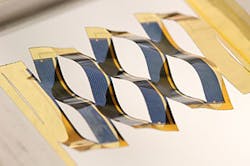Stretched kirigami-patterned thin-film solar cells track the sun
| Cuts in a flexible backing for solar cells allow a flat solar panel to separate into many small cells that can track the sun across the sky. Tracking provides a 20% to 40% improvement in the amount of energy captured by the cells. (Image credit: Aaron Lamoureux, University of Michigan) |
Motorized trackers that keep flat photovoltaic panels pointed toward the sun are, in their conventional form, heavy, bulky, and expensive -- not suited for use on a typical home rooftop. But researchers at the University of Michigan (Ann Arbor, MI) have come up with a way to tilt solar cells in a simple, compact way such that the whole apparatus can fit within a flat solar panel.1 The only requirement is that the solar cells be of the thin-film variety and on a flexible substrate.
The technique is based on Japanese kirigami paper art, and is easily understandable upon seeing the apparatus. A cut pattern consisting of rows of alternating slots allows the array of solar cells, when pulled, to expand and at the same time tilt. The researchers prototype was based on thin-film gallium arsenide (GaAs) solar cells.
"The beauty of our design is, from the standpoint of the person who's putting this panel up, nothing would really change," said Max Shtein, an associate professor of materials science and engineering. "But inside, it would be doing something remarkable on a tiny scale: the solar cell would split into tiny segments that would follow the position of the sun in unison."
The optimized design is effective because it stretches easily, allowing a lot of tilt without losing much width. According to the team's simulations of solar power generation during the summer solstice in Arizona, it is almost as good as a conventional single-axis tracker, offering a 36% improvement over a stationary panel. Conventional trackers produce about 40% more energy than stationary panels under the same conditions, but they are bulky, prone to catching the wind and ten or more times heavier, says Shtein.
"We think it has significant potential, and we're actively pursuing realistic applications," he adds.
The University of Michigan has applied for a patent and is seeking partners to bring the technology to market.
REFERENCE:
1. Aaron Lamoureux et al., Nature Communications (2015); doi: 10.1038/ncomms9092
Source: http://www.engin.umich.edu/college/about/news/stories/2015/september/art-inspired-solar-cells
